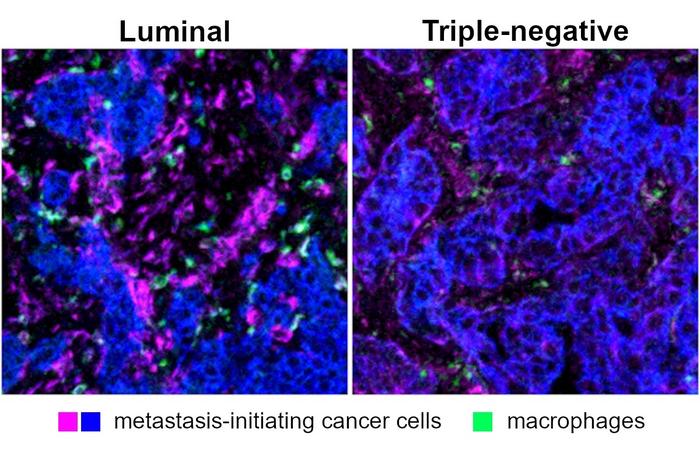In a study using human breast cancer cells, scientists say they have potentially identified immune system white blood cells that appear to be the closest neighbors of breast cancer cells that are likely to spread. The researchers say the finding, focused on a white blood cell called a macrophage, may provide a new biological target for immunotherapies designed to destroy spreading cancer cells that are often markers for worsening disease.

Credit: Won Jin Ho, Johns Hopkins Kimmel Cancer Center
In a study using human breast cancer cells, scientists say they have potentially identified immune system white blood cells that appear to be the closest neighbors of breast cancer cells that are likely to spread. The researchers say the finding, focused on a white blood cell called a macrophage, may provide a new biological target for immunotherapies designed to destroy spreading cancer cells that are often markers for worsening disease.
A report on the findings was published online Aug. 20 in the journal Oncogene.
For the study, researchers at the Johns Hopkins Kimmel Cancer Center used special imaging techniques to see the organization of individual cells within tumors, and built on work by colleagues at the Johns Hopkins Giovanis Institute, whose previous work focused on identifying biomarkers on breast cancer cells that are likely to spread.
“One of the most exciting developments in cancer treatment is immunotherapy — drugs that help the immune system attack a tumor,” says Andrew Ewald, Ph.D., professor and director of the Department of Cell Biology and director of the Johns Hopkins Giovanis Institute. But he notes, such immunotherapies so far work only for a subset of patients, a clear indication that more — and more specific — cellular targets must be identified to broaden the effectiveness of such therapies.
The researchers’ focus on immune system cells is logical, because such cells start their work by getting up close to cancer cells, says Ewald. Touches between cells start a kind of “handshake” process that lets immune cells such as macrophages identify a cell they encounter.
When those encounters occur, the immune system biologically “tags” some as “foreign” to the body and ripe for destruction, while leaving others alone. But one of the hallmarks of cancer cells is their ability to mask their identity and trick the immune system into leaving them alone to grow, change and spread.
In an effort to better determine which cells are closest to breast cancer cells, the Johns Hopkins scientists analyzed primary and metastatic breast cancer tissue samples from 24 people who died from breast cancer and who donated their tissues to Johns Hopkins researchers through a rapid autopsy program.
Kimmel Cancer Center oncologist and imaging expert Won Jin Ho, M.D., used an imaging tool called mass cytometry to analyze and map cells in the tissue samples.
Other scientists have mapped cells in such tissues, but the Johns Hopkins researchers say their study focused not on what surrounds an average cancer cell, but what is closest to those cancer cells that are most likely to spread.
Hundreds of cells span the width of a single tissue sample. “When we analyze dissociated cells, it’s like looking at a smoothie of cells, all blended together, but with imaging, we get to see where all of the pieces are,” says Ho, an assistant professor of oncology and director of the Mass Cytometry Facility at Johns Hopkins.
Ewald and former postdoctoral fellow Eloïse Grasset, Ph.D., now at the National Centre for Scientific Research in France, previously identified the biomarker signature common to breast cancer cells that are likely to spread, or metastasize.
The researchers used 36 of such biomarkers to pinpoint metastasis-initiating cells and other “signatures” to identify cells next to them — those that were up close (within about 10-20 microns), others about three to four cells out, and cells further away.
“What popped out at us, among immune system cells, was a subset of macrophages very close to or touching metastasis-initiating cells in the primary and metastatic tissue samples,” says Ho. The macrophage subsets are a minority — about 1%–5% — of the cells present in the tumor.
The research team confirmed the presence of key macrophage subsets in another set of more than 100 breast cancer samples from a tumor bank published in a previous study, showing that such distinct macrophage subtypes are, indeed, components of the breast cancer microenvironment.
A type of white blood cell, macrophages can swallow and destroy “foreign” cells on their own, but also can recruit other immune system cells to fight off cells they identify as foreign to the body. Ho says that other studies have shown that tumors with many macrophages may indicate a poorer prognosis and less response to immunotherapy.
“As discovery-based scientists, we’re looking for ways to change the immune system’s spatial organization in the microenvironment surrounding cancer cells,” says Ewald. “Eventually, we could develop biologic therapies to change how neighborhoods of cancer cells are organized.”
Other researchers involved in the study are Atul Deshpande, Jae Lee, Yeonju Cho, Sarah Shin, Erin Coyne, Alexei Hernandez, Xuan Yuan, Zhehao Zhang and Ashley Cimino-Mathews from Johns Hopkins.
The authors affiliated with Johns Hopkins University did not declare any conflicts of interest under Johns Hopkins University policies.
Funding for the research was provided by the National Institutes of Health National Cancer Institute (U01CA284090, U54CA268083, P30CA006973, R21CA264004), the Hope Scarves Foundation, the Jayne Koskinas Ted Giovanis Foundation, the Breast Cancer Research Foundation, the Emerald Foundation, Break Through Cancer and the Maryland Cancer Moonshot.
DOI: 10.1038/s41388-024-03127-9
Journal
Oncogene



